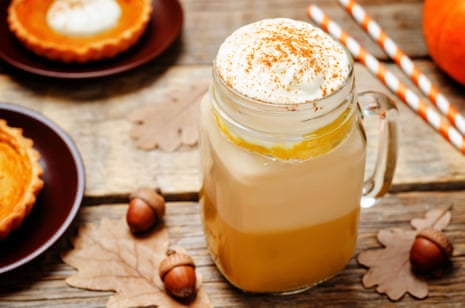In 2009, Colin Nissan, a writer for McSweeney’s, published the profanity-laden paean to fall “It’s Decorative Gourd Season, Motherfuckers”. The piece, written from the perspective of a hyper-enthusiastic fan of autumnal home decor, struck a chord with readers: a decade later, it’s still the site’s second most-read piece.
Perhaps Nissan unwittingly opened a kind of seasonal Pandora’s Box. In the years since his piece was published, ostentatious love for fall has gone from the fringes to the heart of mainstream culture. Every year, earlier and more predictably than the first red leaf or cold night, harbingers of fall enthusiasts appear: people wearing plaids and scarves, Instagram feeds filling with pictures from trips to the apple orchard, shop displays of stuffed fabric pumpkins and leaf-printed tea towels well before the actual first day of fall.
Online, autumn is heralded as the dancing pumpkin man wakes from hibernation, and seasonal cartoons and memes proliferate.
This year, the internet has exulted in “Christian girl autumn”, a meme building off the format of its better-known counterpart “hot girl summer”.
“Christian girl autumn” was born this August, when the Twitter user @lasagnabby tweeted the phrase alongside a photo of “influencer” Caitlin Covington and a friend wearing the autumn ensemble of ankle boots and blanket scarves – the subtext being that loving fall is an uncreative, feminine cliche, the purview of “basics”, itself a term ascribed to women whose cultural tastes are deemed overly conventional.
Hot Girl Summer is coming to an end, get ready for Christian Girl Autumn 🍂😍 pic.twitter.com/yuqyt6YTex
— gio (@lasagnabby) August 9, 2019
It could have felt mean-spirited had Covington and many others – not just Christians and not just girls – not responded by embracing the title and standing by their enthusiasm for autumn and all its old chestnuts.
If all of Twitter is gonna make fun of my fall photos, at least pick some good ones! 🤣 Super proud of these. For the record, I do like pumpkin spice lattes. Cheers! ☕️ pic.twitter.com/QzflqTwqAE
— Caitlin Covington (@cmcoving) August 12, 2019
Whoever made #ChristianGirlAutumn trend, I love you. Thanks for giving me an opportunity to share this embarrassingly basic photo of myself pic.twitter.com/HiGKQgsm2y
— Chelsea Gilson (@ChelseaGilson) August 12, 2019
The autumn spirit, then, is clearly resilient. But why does autumn inspire such intensity of feeling?
The young adult author Jeff Zentner, or, as his friends call him, “the lord of autumn”, is a fall superfan with decorative gourds tattooed to his forearm and a love of cheap pumpkin spice candles.
“I have always loved fall,” he says, “but it’s only recently I’ve come to understand why.”
For Zentner, a former “goth kid”, fall is the ideal time to reflect on mortality, and appreciate that decay is both inevitable and beautiful. “Nature celebrates death in this very tangible way,” he says.
Yet fall isn’t just a time for quiet contemplation; it’s also a lifestyle. Every year, beginning on Labor Day, Zentner transforms his home into a sort of autumn empire, full of dried corn and stuffed ravens from Michaels.
In a recent edition of her perfume-focused newsletter the Dry Down, the writer Rachel Syme observed that the feelings fall evokes are often intense and ambiguous. Come fall, we may feel a heady mix of nostalgic yearning, renewed optimism, and abstract melancholy. We may be sentimental, remembering long-gone school days or how excited we used to be as children, knowing Halloween and Thanksgiving were round the corner. Lacking a better outlet for our complicated emotions, we head to the store to pick up a latte or seasonal wreath.
“Buying stuff is always there, lurking in the places where we feel too much and don’t know what to do with those feelings,” writes Syme.
According to Bruce Clark, an associate professor of marketing at Northeastern University, nostalgia is a particularly effective marketing tool. “There’s some evidence that nostalgia makes people a little less price sensitive,” he says. “There is the idea that seasonal scarcity is something that gets customers excited, so the fact that something is only available for a certain amount of time [in fall] increases demand.”
Perhaps it’s the very tension between fall’s encouragement of thoughtfulness after a carefree summer, and its pre-winter, harvest-bounty-inflected consumerist frenzy that make us go a little wild.
Zentner, however, believes there is no better time than autumn to consciously indulge in consumerism. Unlike Christmas or Valentine’s Day, which are understood to have “true meanings” (piety, generosity, love) that commodification can cheapen and obscure, “there’s not some kind of higher principle of autumn that you can do violence to by commodifying it,” he says.
Marketers certainly seem to be trying to test that theory. A procession of pumpkin spice items hit shelves each year: most recently Spam, peanut butter, and lattes for dogs. According to data from Nielsen and Forbes, the “pumpkin spice industrial complex” was a more than $600m market in 2018.
Starbucks, having launched the pumpkin spice latte in 2004, is the company with the strongest ownership claim on the season, and happily collapses boundaries between corporate product and cherished tradition wherever possible. The company has a verified Twitter account that speaks in the “voice” of its pumpkin spice latte, and runs the “Leaf Raker’s Society”, a two-year-old, 34,000 member-strong “secret” Facebook group “that celebrates fall all year long” and is – I can vouch – extremely wholesome.
What’s left to wonder is if, like “peak oil”, we have reached “peak fall”. Scientists have observed that humanity, by virtue of climate change, has begun to diminish autumn itself – leaves scorched by hotter summers don’t turn glorious hues, pumpkin crops struggle, and in many states it already feels like summer simply runs headlong into winter.
If nature’s cycle of death and decay begins to look, feel, and smell different, will we finally turn our energy toward reappraising the systems that destroyed our most cherished season?

Comments (…)
Sign in or create your Guardian account to join the discussion